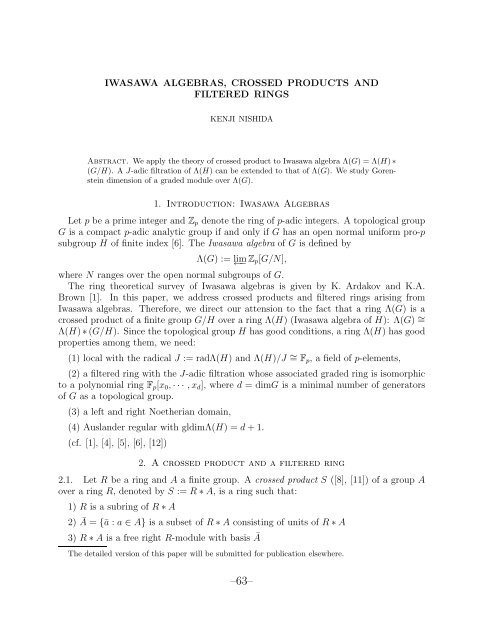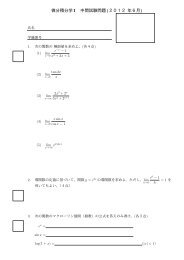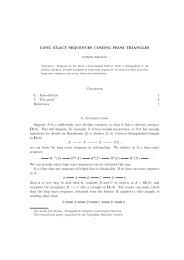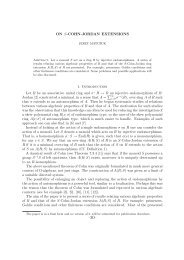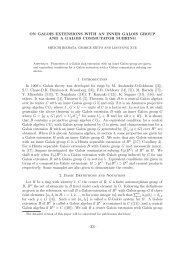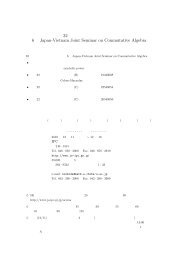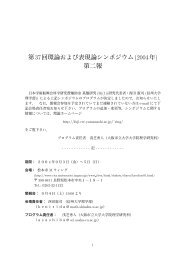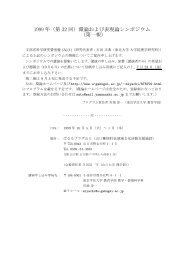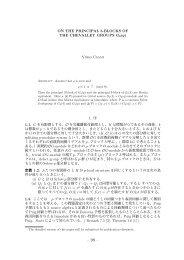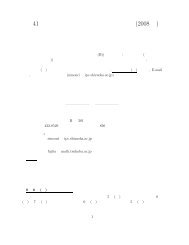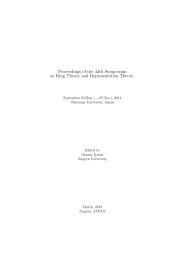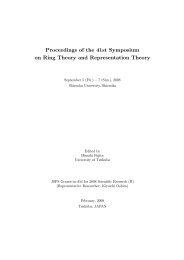Kenji Nishida - FUJI
Kenji Nishida - FUJI
Kenji Nishida - FUJI
You also want an ePaper? Increase the reach of your titles
YUMPU automatically turns print PDFs into web optimized ePapers that Google loves.
IWASAWA ALGEBRAS, CROSSED PRODUCTS AND<br />
FILTERED RINGS<br />
KENJI NISHIDA<br />
Abstract. We apply the theory of crossed product to Iwasawa algebra Λ(G) =Λ(H) ∗<br />
(G/H). A J-adic filtration of Λ(H) can be extended to that of Λ(G). We study Gorenstein<br />
dimension of a graded module over Λ(G).<br />
1. Introduction: Iwasawa Algebras<br />
Let p be a prime integer and Z p denote the ring of p-adic integers. A topological group<br />
G is a compact p-adic analytic group if and only if G has an open normal uniform pro-p<br />
subgroup H of finite index [6]. The Iwasawa algebra of G is defined by<br />
Λ(G) := ←−<br />
lim Z p [G/N],<br />
where N ranges over the open normal subgroups of G.<br />
The ring theoretical survey of Iwasawa algebras is given by K. Ardakov and K.A.<br />
Brown [1]. In this paper, we address crossed products and filtered rings arising from<br />
Iwasawa algebras. Therefore, we direct our attension to the fact that a ring Λ(G) isa<br />
crossed product of a finite group G/H over a ring Λ(H) (Iwasawa algebra of H): Λ(G) ∼ =<br />
Λ(H) ∗ (G/H). Since the topological group H has good conditions, a ring Λ(H) has good<br />
properties among them, we need:<br />
(1) local with the radical J := radΛ(H) and Λ(H)/J ∼ = F p , a field of p-elements,<br />
(2) a filtered ring with the J-adic filtration whose associated graded ring is isomorphic<br />
to a polynomial ring F p [x 0 , ··· ,x d ], where d = dimG is a minimal number of generators<br />
of G as a topological group.<br />
(3) a left and right Noetherian domain,<br />
(4) Auslander regular with gldimΛ(H) =d +1.<br />
(cf. [1], [4], [5], [6], [12])<br />
2. A crossed product and a filtered ring<br />
2.1. Let R be a ring and A a finite group. A crossed product S ([8], [11]) of a group A<br />
over a ring R, denoted by S := R ∗ A, is a ring such that:<br />
1) R is a subring of R ∗ A<br />
2) Ā = {ā : a ∈ A} is a subset of R ∗ A consisting of units of R ∗ A<br />
3) R ∗ A is a free right R-module with basis Ā<br />
The detailed version of this paper will be submitted for publication elsewhere.<br />
–63–
4) For all a, b ∈ A, the equalities āR = Rā and ā¯bR = abR hold.<br />
Remarks. (see [11]) (1) We may assume ¯1 A =1 S . A left R-module R ∗ A is also free<br />
with basis Ā. Usually, we write<br />
R ∗ A = ⊕ āR.<br />
a∈A<br />
(2) There exists a map σ : A → AutR such that rā =ār σ(a) , r ∈ R, a ∈ A. In what<br />
follows, we shortly write rā =ār a . There exists a map τ : A × A → U(R) such that<br />
ā¯b = abτ(a, b). In order to assure the associativity of R ∗ A, maps σ, τ satisfy some<br />
conditions (see [11]).<br />
We start with the theorem which implies that the Iwasawa algebra is Auslander Gorenstein.<br />
A ring R is said to satisfy Auslander condition, if, for all finitely generated left R-<br />
module M, for all i ≥ 0 and for all right R-submodules N of Ext i R (M,R), grade of N is<br />
greater than or equal to i, where grade of an R-module X is inf{j ≥ 0 : Ext j R<br />
(X, R) ≠0}.<br />
Theorem 1. Let S = R ∗ A be a crossed product. Then idR =idS holds, where id stands<br />
for injective dimension. Moreover, if R satisfies Auslander condition, then S satisfies it,<br />
too.<br />
Proof. It follows from [2] that, for all finitely generated left S-modules M and for all<br />
i ≥ 0,<br />
Ext i S (M,S) ∼ = Ext i R (M,R).<br />
The statement is an easy consequence of this formula. □<br />
Since gldimΛ(H) =d + 1, we see idΛ(H) =d + 1. Hence Λ(G) is Auslander Gorenstein<br />
of idΛ(G) =d +1.<br />
2.2. A ring R is called a filtered ring with a filtration F = {F i R} i∈ if<br />
i) F i R is an additive subgroup of R for all i ∈ Z and 1 ∈F 0 R,<br />
ii) F i R ⊂F i+1 R (i ∈ Z),<br />
iii) (F i R)(F j R) ⊂F i+j R (i, j ∈ Z),<br />
iv) ∪ i∈F i R = R.<br />
([7])<br />
Let S = R ∗ A be a crossed product and further, assume that R is a filtered ring. Then<br />
a filtration F is called A-stable, if<br />
v) (F i R) a ⊂F i R for all a ∈ A and i ∈ Z.<br />
Let grR = ⊕ p∈F p R/F p−1 R an associated graded ring of R. Then forming a crossed<br />
product ‘∗’ and an associated graded ring ‘gr’ commutes each other.<br />
–64–
Theorem 2. Let R, A, S be as above. Assume that R is a filtered ring with an A-stable<br />
filtration such that every unit of R sits in F 0 R \F −1 R. Then F ′ := {F iS} ′ i∈, F iS ′ =<br />
⊕ a∈A ā(F i R)(i ∈ Z), is a filtration of S and there is a ring isomorphism<br />
gr F ′S ∼ = (gr F R) ∗ A.<br />
We put the J-adic filtration F = {F i Λ(H)} i∈ of Λ(H) by<br />
{<br />
J<br />
F i Λ(H) =<br />
−i (i0, where<br />
M ∗ = Hom R (M,R). For a positive integer k, M is said to have Gorenstein dimension<br />
less than or equal to k, denoted by G-dim M ≤ k, if there exists an exact sequence<br />
0 → G k → ···→ G 0 → M → 0 with G-dim G i = 0 for 0 ≤ i ≤ k. We have that G-dim<br />
–65–
M ≤ k if and only if G-dim Ω k M = 0. It is also proved that if G-dim M
3.1. Concluding Remarks. Let M be a graded Λ(G)-module and take a good filtration<br />
of M 1 ([7]). Then the following (in)equalities hold:<br />
G-dim Λ(G) M + m-depth(grM 1 ) ≤ d +1<br />
grade Λ(G) M + dim grΛ(H) (grM 1 )=d +1,<br />
where m is the ∗ maximal ideal of grΛ(H) =F[x 0 , ··· ,x d ].<br />
These formulae will be able to apply to homological theory of modules over the Iwasawa<br />
algebra. For example:<br />
Suppose that grM 1 is Cohen-Macaulay, then M is perfect, i.e., grade Λ(G) M = G-dim Λ(G) M.<br />
References<br />
[1] K. Ardakov and K.A. Brown, Ring-theoretic properties of Iwasawa algebras: A survey, Documenta<br />
Mathematica, Extra volume Coates (2006) 7–33.<br />
[2] K. Ardakov and K.A. Brown, Primeness, semiprimeness and localisation in Iwasawa algebras, Trans.<br />
AMS. 359, no.4, (2007) 1499–1515.<br />
[3] M. Auslander and M. Bridger, Stable module theory, Mem. of the AMS 94, Amer. Math. Soc.,<br />
Providence 1969.<br />
[4] J. Coates, P. Schneider and R, Sujatha, Modules over Iwasawa algebras, J. Inst. Math. Jussieu 2,<br />
(2003) 73–108.<br />
[5] J. Coates, T. Fukaya, K. Kato, R. Sujatha, O. Venjakob, The GL 2 main conjecture for elliptic curves<br />
without complex multiplication, Publ. Math. IHES 101 (2005) 163–208.<br />
[6] J.D. Dixon, M.P.F. Du Sautoy, A. Mann, D. Segal, Analytic pro-p groups, 2nd edition, CUP 1999.<br />
[7] L. Huishi and F. Van Oystaeyen, Zariskian Filtrations, K-Monographs in Mathematics, 2, 1996.<br />
[8] J.C. McConnell and J.C. Robson, Noncommutative Noetherian rings, Wiley-Interscience, 1987.<br />
[9] C. Nǎstǎsescu and F. Van Oystaeyen, Graded Ring Theory, North-Holland Math. Library, Amsterdam,<br />
1982.<br />
[10] C. Nǎstǎsescu and F. Van Oystaeyen, Methods of Graded Rings, LNM 1836, Springer, 2004.<br />
[11] D. Passman, Infinite crossed products, Pure and Applied Mathematics, vol.135, Academic Press,<br />
1989.<br />
[12] O. Venjakob, On the structure theory of the Iwasawa algebra of a compact p-adic Lie group, J. Eur.<br />
Math. Soc. (JEMS) 4, no.3 (2002) 271–311<br />
Department of Mathematical Sciences<br />
Shinshu University<br />
Matsumoto, Nagano 390-8621 JAPAN<br />
E-mail address: kenisida@math.shinshu-u.ac.jp<br />
–67–


